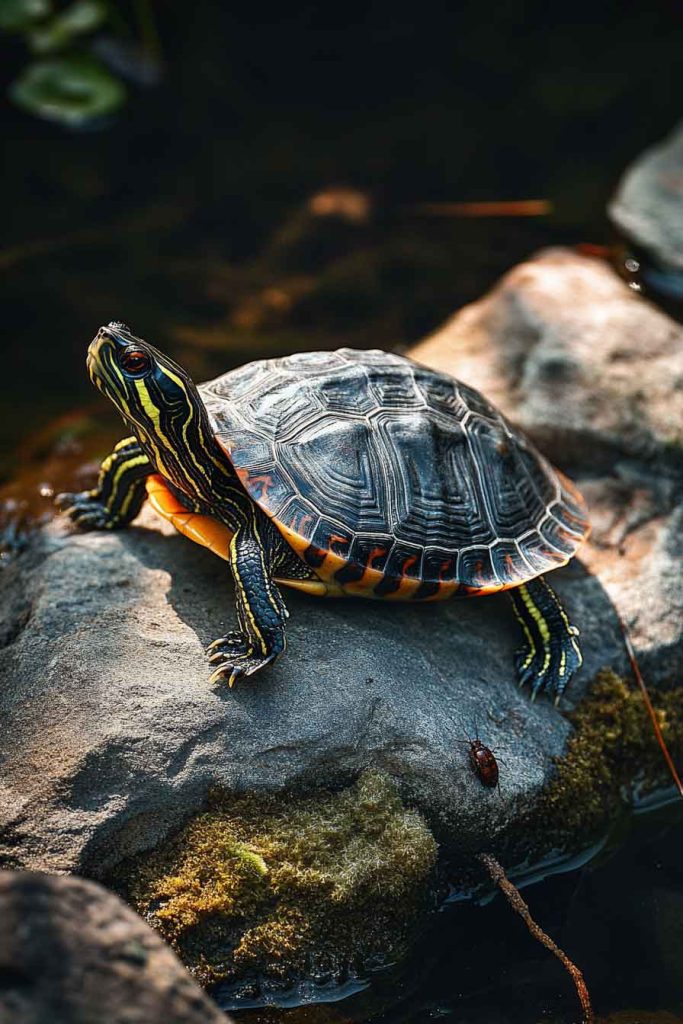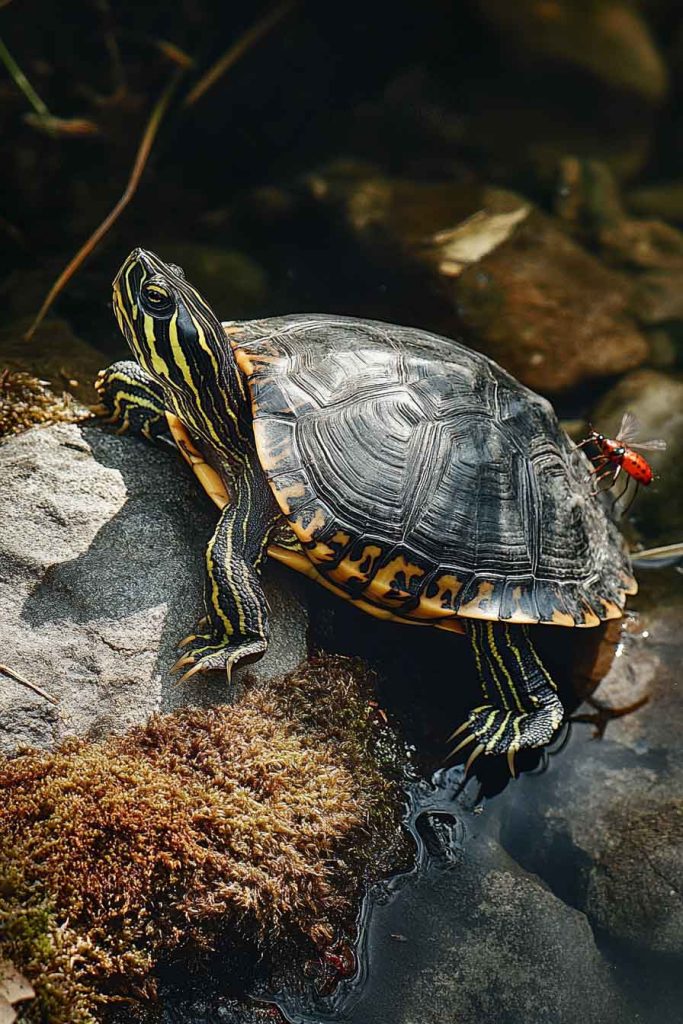Do Red-Eared Slider Turtles Bite? Are the Bites Poisonous or Dangerous?
So, you’re thinking about getting a red-eared slider? Or maybe you already have one paddling around in its tank and you’re wondering, “Wait… do these guys bite?” I get it—I asked the same question when I first brought one home. Let me cut to the chase: yes, red-eared sliders can and do bite. But here’s…
So, you’re thinking about getting a red-eared slider? Or maybe you already have one paddling around in its tank and you’re wondering, “Wait… do these guys bite?” I get it—I asked the same question when I first brought one home.
Let me cut to the chase: yes, red-eared sliders can and do bite. But here’s the reassuring part—their bites are not poisonous or venomous. They might sting, sure. They might even leave a scratch or bruise. But they’re not dangerous in that life-or-death kind of way. In this post, I’ll break down why they bite, how bad it can get, and what to do if you ever get nipped.
Let’s get into it.
Do Red-Eared Slider Turtles Bite?
Yes, they do bite—but not without a reason. Red-eared sliders, like most turtles, don’t just go around attacking people. They’re more likely to bite when they feel scared, provoked, or confused—especially if you’re getting too close, handling them improperly, or dangling your fingers near their mouth at feeding time.

Now, they don’t have teeth like we do. Instead, they’ve got sharp, beak-like mouths designed for tearing into vegetation, insects, and protein-based food. These beaks are made of keratin (same stuff as your fingernails), and they’re surprisingly strong. Trust me—you’ll feel it if one bites down on you.
In my experience, adult sliders have enough jaw strength to break the skin, especially if they’re large and feisty. Baby turtles or juveniles? Their bites usually feel more like a hard pinch or a rubber band snap.
But here’s the most important part: red-eared slider bites are not poisonous. They don’t inject venom. There’s zero risk of toxins from the bite itself. The real concern is infection—and we’ll get to that in a moment.
Red-Eared Slider Turtle Bites
Let’s talk about what a bite actually feels like—because yes, I’ve been bitten. A few times.
- Minor nip: Feels like a pinch or a clip from a nail. You’ll probably say “ouch” and move on.
- Medium bite: Might leave a red mark or slight bruise. Still manageable, but you’ll remember it.
- Hard bite (from a large adult): Could break the skin, draw blood, and leave a real sting. It’s rare, but it happens—especially when turtles are mishandled or startled.
In most cases, you’ll see redness or mild swelling. Occasionally a bruise. A deeper bite might draw a little blood, but it usually stops quickly. I’ve never needed stitches or a doctor visit, but I always disinfect just to be safe.
Pro tip from experience: Do not yank your hand away if a turtle latches on. That sudden pull can make things worse. Let them release on their own or gently coax their jaws open.
Also, keep in mind that a bite is more likely in water, where they feel most secure and territorial—especially during feeding time. Sliders can get competitive, and when food’s involved, fingers can easily get mistaken for treats.
Why Red-Eared Slider Turtles Might Bite You
So, why does a usually chill turtle suddenly turn into a tiny snapping machine? Based on years of experience (and a few unexpected nips), here are the main reasons:
1. Feeling Threatened or Cornered
Turtles are prey animals at heart. If they feel trapped or unsafe—especially if you’re looming over them, picking them up suddenly, or tapping their shell—they might bite as a reflex. It’s not aggression, it’s survival.
2. Mistaking Fingers for Food
This is the big one. I’ve had turtles nip at my fingers because they smelled like shrimp pellets or veggies. Their vision outside water isn’t great, and if your hand is moving near the surface during feeding time, they might lunge without thinking.
3. Being Provoked or Mishandled
Trying to force them out of their shell? Poking at them while basking? Yeah, that’s asking for trouble. Even the calmest turtle can snap if it feels disrespected. Respect their space.
4. Stress or Overstimulation
Turtles can get stressed too. Loud noises, rough handling, sudden changes in their habitat—all of this can make a red-eared slider nervous. And when they’re nervous, they’re more likely to bite.
5. Territorial Behavior
This is more common in males or turtles during mating season. They may bite out of dominance or irritation—especially if there are multiple turtles in the tank.

Are Red-Eared Slider Turtle Bites Poisonous?
Let’s clear this up once and for all—no, red-eared slider turtle bites are not poisonous. They don’t carry venom, and there’s nothing toxic in their saliva. So if your turtle bites you, you don’t need to worry about any kind of poison entering your system.
That said, there is a real concern: bacteria. Turtles—especially aquatic species like sliders—can carry Salmonella on their skin and in their mouths. If they bite and break the skin, bacteria can enter the wound and cause an infection.
From my personal experience, I always treat a bite seriously—even if it’s just a scratch. Here’s what I do right away:
- Wash the wound with warm water and antibacterial soap.
- Apply a disinfectant like hydrogen peroxide or rubbing alcohol.
- Use an antibiotic ointment and keep the area clean and covered.
If the bite looks deep, swollen, or starts turning red after a day or two, I’d recommend seeing a doctor just to be safe.
What Happens When a Red-Eared Slider Bites You?
Honestly, it depends on the size of the turtle and the way you got bit. Let me break down what might happen—based on both my own experience and what I’ve seen from other owners:
- A light nip from a hatchling or juvenile might feel like a tap or a tickle. There’s usually no damage at all.
- A medium bite (say, from a 3–5-inch turtle) might leave a small red mark or cause a minor scratch.
- A hard bite from a full-grown adult (especially one over 8 inches) could leave a bruise, cause bleeding, or even break the skin.
And like I mentioned before, don’t pull away if your turtle is still latched on. They can clamp down harder if startled. Just stay calm, and they’ll usually let go once they realize you’re not food.
Also, it’s good to know that red-eared sliders rarely bite without warning. Most of the time, they’ll show signs of being uncomfortable first—like backing away, hissing, or retreating into their shell. Learn to recognize those signs, and you can avoid most bites altogether.
Can a Red-Eared Slider Turtle Bite Off a Finger or Toe?
No, they can’t. I’ve been asked this a lot—and the answer is a big nope. Red-eared sliders, even large adults, just don’t have the jaw power to sever a finger or toe. They might bruise, cut, or pinch, but they’re not strong enough to bite anything off.
If you’re looking for turtles that can do real damage, that’s where alligator snapping turtles come in. Those guys are another story entirely—they can crush bone. But red-eared sliders? Not even close.
What To Do If a Red-Eared Slider Turtle Bites You
Alright—so let’s say you got bit. What now? Here’s what I always do and recommend:
- Stay calm – Don’t yank your hand or foot back. Sudden movements can make the turtle panic and bite harder.
- Gently separate – Wait for the turtle to release, or slowly push near the corners of its mouth (not too forcefully).
- Clean the wound – Wash the bite with soap and water immediately. Use a disinfectant like alcohol or iodine.
- Apply ointment – Use an over-the-counter antibiotic cream.
- Bandage it up – Keep it clean and covered to avoid infection.
- Monitor for infection – Redness, swelling, warmth, or pus? Time to call a doctor.
I’ve had slider bites heal in just a few days with no issues—but prevention is always better than dealing with a wound.
How To Avoid Getting Bitten by a Red-Eared Slider
Over the years, I’ve learned that most bites are avoidable. Red-eared sliders aren’t aggressive by nature—they bite when they’re scared, confused, or hungry. So here are some of my go-to tips to help you avoid getting nipped:
- Don’t hand-feed them – Especially when they’re excited or swimming fast. Use tongs, a feeding dish, or drop the food in the water.
- Wash your hands before and after handling – If your hands smell like food, they’ll think they’re getting a snack.
- Avoid sudden movements – Pick them up slowly and confidently. Startling them usually triggers defensive behavior.
- Respect their space – Don’t poke, tap, or try to pry them out of their shell.
- Handle gently and minimally – Red-eared sliders aren’t cuddly pets. Limit handling to necessary moments like cleaning or health checks.
And always feed your turtle on time. Hungry turtles are way more likely to go for your fingers thinking it’s food.
How Do I Pick Up a Red-Eared Slider Without Getting Bit?
Great question—and I’ve learned this one the hard way.
Here’s the safest method:
- Approach from behind – Never from the front where they can see your fingers.
- Slide your hands under their body – Support them with both hands, especially if they’re heavy.
- Hold firmly but gently – Keep your thumbs on the top shell (carapace) and fingers under the plastron (bottom shell).
- Avoid the head and legs – Don’t touch near their mouth or front legs—they’ll be more likely to strike if they feel vulnerable.
Important: Never grab a turtle by its tail. It can injure their spine and cause long-term damage.
FAQ
1. Do red-eared slider turtle bites hurt?
Yes, they can—especially from adults. Smaller turtles might just pinch, but a full-grown red-eared slider can bite hard enough to draw blood.
2. Can a red-eared slider bite off a finger?
No, absolutely not. They don’t have the jaw strength to do that. You might get scratched or bruised, but nothing more.
3. Are red-eared slider bites poisonous?
Nope! Their bite isn’t venomous or toxic. The only risk is infection if you don’t clean the wound properly.
4. Why does my red-eared slider keep trying to bite me?
It’s probably scared, stressed, or mistaking you for food. Review how you handle and feed it—and try to avoid putting your hands near its face.
5. Do red-eared sliders bite each other?
Yes, sometimes. Especially during mating, over territory, or when competing for food. If you see repeated aggression between turtles, it might be time to separate them.
Final Thoughts
So, do red-eared slider turtles bite? Yes, they do—but only when they feel like they have to. Whether it’s fear, confusion, or hunger, there’s always a reason behind the nip. And the good news? Their bites aren’t poisonous.
Just be smart about how you handle and feed your slider, and you’ll rarely—if ever—have to worry about getting bitten. I’ve kept these turtles for years, and once you understand their behavior, they’re honestly pretty chill companions.
Still worried about bites? Learn more about turtle behavior and care in our other articles on slider feeding, handling, and health.







